what we learned ❘ By MARK WATERS
The Taco Bell restaurant in New London, Connecticut, was built in 1992 of Type V, Wood Frame construction and featured the typical design the restaurant chain built during that time. The clay roof tile section was mansard, and the middle was flat roof with the heating, ventilation, and air-conditioning (HVAC) units in that area. The walls were constructed of 2 × 6 wood wall studs, and the roof was wood truss construction covered with wood plywood and terra cotta roof tiles. The building contained a drop ceiling throughout and had no fire alarm system or fire protection systems other than a fire extinguisher in the kitchen. The exterior of the building had no markings or indications that it contained a truss constructed roof.
![(1) Conditions as the first hoseline was being stretched. [Photos by Steven Frischling/Waterford (CT) Fire Department unless otherwise noted.]](https://emberly.fireengineering.com/wp-content/uploads/2018/04/1804FE_WWLPic1.jpg)
(1) Conditions as the first hoseline was being stretched. [Photos by Steven Frischling/Waterford (CT) Fire Department unless otherwise noted.]
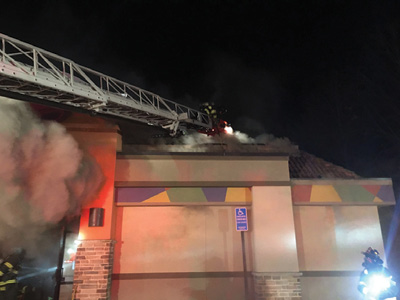
(2) Vertical ventilation by the first-due truck on the D side.
Many of the firefighters who initially arrived on scene were not employed by the New London (CT) Fire Department (NLFD) at the time this building was constructed. The NLFD also did not have a prefire plan on file for this building at the time of the fire. The NLFD’s bread-and-butter type of fire is usually a one- to three-family residential building; the department rarely encountered working fires in commercial buildings, especially fast food restaurants, in the city.
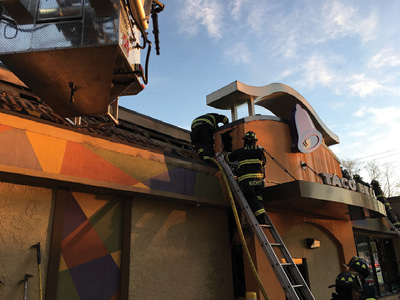
(3) Overhaul of the drive-through area on the B side.
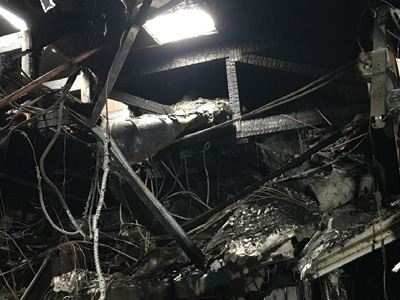
(4) View of an inside truss chord in the kitchen area. (Photo by author.)
The Incident
On November 11, 2017, the New London Communications Center received a call for a hold-up (burglar) alarm at 404 Colman Street at approximately 0503 hours. The center dispatched two police officers to investigate. On arrival, the first-arriving police officer discovered that the restaurant was on fire and requested the NLFD. At approximately 0511 hours, the NLFD was dispatched to the restaurant for a reported structure fire. The responding assignment included the shift commander (battalion chief), three engine companies with a lieutenant and two firefighters each, a truck company with two firefighters, and two ambulances with two firefighters each, for a total initial response of 16. The building had been unoccupied for just a few hours at the time police discovered the fire. The first-due engine and the battalion chief arrived on scene minutes after the initial dispatch; the battalion chief then quickly declared the incident a working fire.
Heavy smoke pushed from the roof area and covered the adjacent parking lot and street area around the restaurant. The first-due engine pulled into the parking area on the D side of the building; the engine’s officer then performed a quick size-up and determined that the bulk of the fire was in the kitchen area of the restaurant. Firefighters were ordered to force entry through the side doors on the D side. The first-due engine’s crew then stretched a 1¾-inch hoseline and entered the building using a thermal imaging camera (TIC) to determine the location and extent of the fire. Conditions at the time showed smoke to the floor, zero visibility, and high heat (photo 1).
The crew charged the hoseline at the door and located the fire in the ceiling area of the kitchen; the fire was also extending into the dining room area. The crew directed the hose stream into the ceiling area to remove ceiling tiles and stop the fire’s progress. The second-due engine company then secured a water supply from a hydrant that was approximately 400 feet away. Once the water supply was secured, the second-due engine company stretched a 2½-inch hoseline through the side entry door to back up the first hoseline that was already operating. At this time, an emergency button on a firefighter’s portable radio activated, alerting the incident commander (IC) to call for an evacuation and perform a personal accountability report. The IC completed these actions quickly, and firefighting operations commenced. The first-due truck company then performed vertical ventilation during firefighting operations from the aerial ladder (photo 2).
A second alarm was then transmitted, bringing mutual aid to the scene and apparatus to cover the city’s now vacant fire stations. Initial companies began running low on air; they started exiting the building to change out for full bottles of air. After both hoselines knocked down the fire and the smoke began to clear, the overhead area (where most of the fire was located) was now visible.
Once visibility improved, crews determined that the roof above the kitchen area was wood truss and deemed it immediately unsafe. The IC then called for horizontal ventilation after the knockdown to improve conditions, and the truck company broke the large windows in the restaurant’s dining room area. Companies were advised of the conditions and told to stay away from the kitchen area because of numerous roof chords that were burned through. One firefighter became entangled in the wires that held the grid for the ceiling tiles; members used wire cutters to remove the firefighter from further harm.
A short time later, crews placed the fire under control and continued overhaul over the next hour. Additional truck companies used aerial ladders to cut holes in the roof area to reach pockets of the fire. One area that was difficult to gain access to was the large void area above the restaurant’s drive-through. Additional companies that arrived on the second alarm overhauled this area with saws and numerous tools. To this date, the cause of the fire has not been determined because of the building’s unsafe condition, which restricted access to investigators (photo 3).
Lessons Learned
One of the reasons I wrote this article was that I believe that luck was on our side that morning. However, we can’t rely on luck. When my crew and I entered the building that morning, I immediately thought of a similar “fast food” restaurant fire that occurred in Houston, Texas, in February 2000. That fire, which happened at a McDonald’s, killed two of Houston’s bravest who were working on the interior when the roof collapsed from excess weight. Although I have spoken about that fire several times while training other firefighters, I never thought I would be faced with very similar conditions.
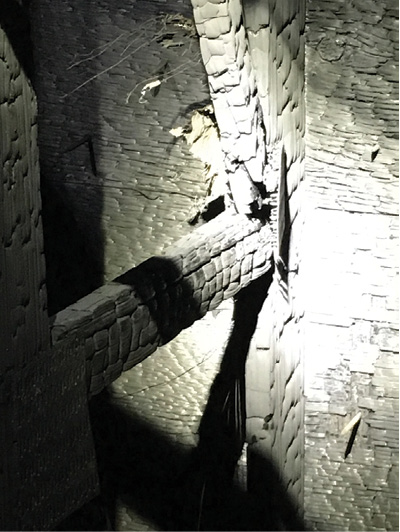
(5) View of gusset plates popping off from the heat of the fire. (Photo by author.)
The lessons learned from this fire include the following:
Always preplan. The NLFD should have known that this building’s roof was constructed of a wood truss. After these buildings are built and open for business, we enter them many times to buy food. Take some time and fully preplan these buildings. I did not; from the view of the building’s exterior, I would not have guessed it was truss. Would you have known? If your answer is “I’m not sure,” ask these buildings’ managers if you can observe the building before you respond to it and have zero-visibility conditions. The weight of the HVAC components on the roof combined with the extent of the fire should have caused a catastrophic collapse. A structural engineer was brought in postfire, and he also stated that the roof should have failed because seven truss chords had burned through completely (photos 4, 5).
Choose the correct hoseline. The NLFD is a small career fire department with limited staffing, so I opted to start with a 1¾-inch hoseline; if I could have “reset the clock,” I would have started with a 2½-inch and waited an extra minute until I had additional firefighters to operate it. I was amazed at the difference between the two lines when attacking this fire.
There should be no sense of urgency in this case; the building was unoccupied and contained no external exposures. Fire officers and firefighters should take the time to establish the right size line, put it in the right place, and ensure it is there at the right time. If there is no life hazard, commence a defensive outside attack while establishing a collapse zone.
Use a TIC. The TIC is by far one of the most useful tools ever invented for the officer or firefighter. It allowed me to quickly locate the main body of fire though heavy smoke and zero-visibility conditions. The newer TICs also indicate the temperature of the fire even if you can’t feel it.
Perform ventilation. Do not perform vertical ventilation unless you are on an aerial device and with the highest level of safety (photo 6). Use extreme caution because of the strength of the windows; some are now hurricane windows.
At this fire, one firefighter sustained a heart attack while breaking the dining room windows. It is believed to have been caused by the force that he exerted to break one of the windows. These windows happened to be hurricane-force windows and require great force to break. The firefighter is still on injury leave and recovering from his injuries.
Consider the building’s fire protection systems. This building did not contain a fire alarm or fire protection system. After talking to the owner of another area fast food restaurant, I now refer to these buildings as “dumpster” buildings. In other words, these buildings will end up being torn down, placed in a dumpster, and rebuilt. Many of them are not even insured for fires.
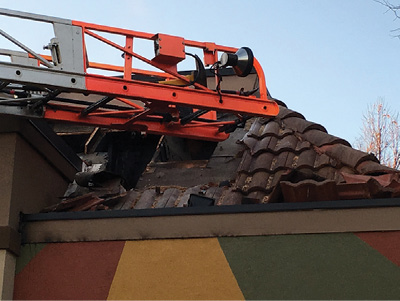
(6) View of the roof layers including the terra cotta tile on the roof.
Firefighter safety. Essentially, we stretched into a closed, unoccupied restaurant and placed firefighters in unnecessary danger. In the future, I will not use the fact that we were lucky in this incident to try this tactic again; crews should fight fires in a “dumpster” building with no life hazard in a defensive fashion and without putting themselves in the collapse zone. If there is a life hazard and you need to make a rescue in an offensive position, ensure that firefighters possess wire cutters and that they are aware of any and all exit points. Once rescues have been completed, firefighters should switch to a defensive mode.
MARK WATERS is a 25-plus-year fire service veteran and a lieutenant with the New London (CT) Fire Department. He is also a program planner for the Connecticut Fire Academy and is responsible for its Fire Officer Training Programs. Waters graduated from the National Fire Academy’s Executive Fire Officer Program and has an M.S. degree in executive fire service leadership.

